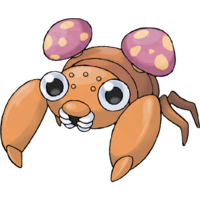From Bulbapedia, the community-driven Pokémon encyclopedia.
|
|
| Line 73: |
Line 73: |
| ; [[Pokémon FireRed]] | | ; [[Pokémon FireRed]] |
| : Growing out of the bug's back are mushrooms called tochukaso. The mushrooms grow with the bug host. | | : Growing out of the bug's back are mushrooms called tochukaso. The mushrooms grow with the bug host. |
| | ; [[Pokémon Diamond]] |
| | :Mushrooms named tochukaso grow on its back. They grow along with the host PARAS. |
|
| |
|
| ==Game locations== | | ==Game locations== |
Revision as of 06:11, 3 May 2007
|
|

Artwork from FR/LG
|
|
|
|
|
|
|
|
|
|
|
|
Height
1'00"
Imperial
|
0.3 m
Metric
|
1'00"/0.3 m
Red-Striped
|
0'0"/0.0 m
Blue-Striped
|
0'0"/0.0 m
|
|
|
Weight
11.9 lbs.
Imperial
|
5.4 kg
Metric
|
11.9 lbs./5.4 kg
Red-Striped
|
0.0 lbs./0.0 kg
Blue-Striped
|
0.0 lbs./0.0 kg
|
|
|
|
|
|
|
|
|
|
|
|
|
EV yield
HP
0
|
Atk
0
|
Def
0
|
Sp.Atk
0
|
Sp.Def
0
|
Speed
0
|
| Base Exp.: 70
|
Battle Exp.: 701*
|
|
|
|
|
Paras (Japanese: パラス Paras) is a Bug/Grass-type Pokémon.
Biology
Physiology
Gender differences
None.
Special abilities
Behavior
Habitat
Paras can often be found in caves, since sunlight and dry air hurt their skin. They can also thrive in dank forests with lots of humidity where conditions are ideal for fungi.
Diet
Main article: Pokémon food
In the anime
Paras first appears in EP044. Team Rocket helps it get stronger and evolve.
Game data
Pokédex entries
- Pokémon Red and Blue / Pokémon LeafGreen
- Burrows to suck tree roots. The mushrooms on its back grow by drawing nutrients from the bug host.
- Pokémon Yellow
- Burrows under the ground to gnaw on tree roots. The mushrooms on its back absorb most of the nutrition.
- Pokémon Stadium
- Grows by sucking nutrients from the roots of trees. The mushrooms on its back grow by drawing nutrients from the bug host.
- Pokémon Gold
- It is doused with mushroom spores when it is born. As its body grows, mushrooms sprout from its back.
- Pokémon Silver
- As its body grows large, oriental mushrooms called tochukaso start sprouting out of its back.
- Pokémon Crystal
- The tochukaso growing on this Pokémon's back orders it to extract juice from tree trunks.
- Pokémon Ruby and Sapphire
- Paras has parasitic mushrooms growing on its back called tochukaso. They grow large by drawing nuitrients from this Bug Pokémon host. They are highly valued as a medicine for extending life.
- Pokémon Emerald
- A Paras has parasitic tochukaso mushrooms growing on its back. They grow by drawing nutrients from the host. They are valued as a medicine for long life.
- Pokémon FireRed
- Growing out of the bug's back are mushrooms called tochukaso. The mushrooms grow with the bug host.
- Pokémon Diamond
- Mushrooms named tochukaso grow on its back. They grow along with the host PARAS.
Game locations
| This Pokémon was unavailable prior to Generation I.
|
|
|
|
|
|
|
|
|
|
|
|
|
In side games
Base stats
| Stat
|
Range
|
| At Lv. 50
|
At Lv. 100
|
35
|
|
95 - 142
|
180 - 274
|
70
|
|
67 - 134
|
130 - 262
|
55
|
|
54 - 117
|
103 - 229
|
45
|
|
45 - 106
|
85 - 207
|
55
|
|
54 - 117
|
103 - 229
|
25
|
|
27 - 84
|
49 - 163
|
Total: 285
|
Other Pokémon with this total
|
- Minimum stats are calculated with 0 EVs, IVs of 0, and (if applicable) a hindering nature.
- Maximum stats are calculated with 252 EVs, IVs of 31, and (if applicable) a helpful nature.
- This Pokémon's Special base stat in Generation I was 55.
|
Type effectiveness
Template:DP type effectiveness
In Generation I, the effectiveness of Poison-type moves is 400.
Learnset
Template:Learnset intro
Special Moves
In Pokémon XD: Gale of Darkness, Paras knows Shadow Blitz and Shadow Shed as a Shadow Pokémon, and learns Refresh after being purified.
Side game data
Template:Side game
Evolution
Trivia
Paras's name was originally "Parasyte".
Origin
There are many forms of fungus that grow on insects, any one of which could have inspired Paras's design, like the entomophthora muscae, which grows on the back of the common housefly.
Name origin
Paras's name is a shortening of the word parasite, referring to the parasitic mushrooms growing on its back.
In other languages
External links

|
This Pokémon article is part of Project Pokédex, a Bulbapedia project that aims to write comprehensive articles on each Pokémon species, as well as Pokémon groups and forms.
|


